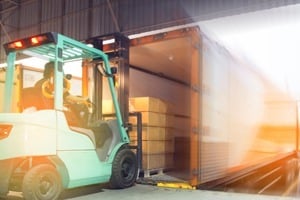What is a load unit?
In logistics, so-called load units are almost always used as the basic unit for the storage and transportation of goods. The goods are then packed either in modular packaging such as a crate or on a loading aid (also known as a load carrier) such as a pallet.
The resulting load unit can be transported and stored much more efficiently than individual items or cartons. However, not every warehouse can handle every load unit at the same time. For example, there are pallet-only warehouses in which only palletized goods can be stored.
Load units are handled at all possible work points along the logistics chain, for example during transportation, in a picking warehouse or even before production. The modular packaging used for this are, for example:
- Pallets
- Crates
- Container
- Barrels
- Container
- Lattice boxes
Below we explain how load units can be subdivided and what advantages and disadvantages they have.
How are load units subdivided?
Most load units can be subdivided into smaller elements, each of which can be handled individually. The smallest logistical unit is the order preparation unit. This is the smallest unit delivered to a customer when a product is sold. For example, this could be a box containing 20 individual sets of cutlery.
In order to ensure optimum operation during production, distribution or sales, the units packed in load units can be further subdivided for order preparation. For example, order preparation units contain delivery units, which in turn combine the final sales or production units.
Summary:
A load unit (packed pallet) therefore consists of a large number of units for order preparation (individual cartons) which are arranged in several layers or covers on top of each other. Each order preparation unit in turn contains several delivery units in which the sales units (set of 12 tissue packs) are packed. These then contain the actual item, such as the individual packs of tissues, which are also called consumption units in a logistical context.
What are the advantages and disadvantages of load units in logistics?
Load units offer great advantages in logistics. They make it possible to combine a large number of individual units for order preparation. This means, for example, that 20 cartons can be moved at once by simply transporting the entire load unit. This means that not every box has to be moved individually.
However, load units require an investment for the load carriers used, such as pallets or containers. To make this worthwhile, the packed units should remain together for as long as possible and not be broken up. However, most loading units can be used several times, which spreads the costs relatively well.
Are there different forms of loading unit?
In logistics, loading units are divided into three groups.
- Load units with load-bearing function
These include, for example, Euro flat pallets or industrial pallets. These can also be stacked on top of each other when loaded and can be made of a wide variety of materials such as wood or plastic.
- Loading unit in enclosing form
These provide all-round protection for the transported goods by surrounding them with integrated walls. This loading unit includes, for example, solid wall box pallets or lattice boxes.
- Loading unit in final form
These include, for example, intermodal containers, air freight containers (ULDs) and swap bodies. These loading units can be locked from the outside and therefore offer even better protection.
